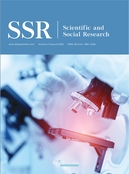Abstract
Bacillus cereus is a foodborne, conditional pathogen that causes vomiting and diarrhea and has become a rising threat to food safety. This review introduces several major types of B. cereus detection methods (including traditional methods, PCR-based assays , immunological assays, cytotoxicity assays, and a CBD-related assay) and species-specific disinfection methods (including AMPs and endolysins). These methods have either been applied or have the potential to be applied in the food industry. The intention of this review is to introduce the principle of these methods and evaluate their strengths and weakness.
References
Savini, V, 2016, Chapter 6- Bacillus cereus Pneumonia, in Diverse Faces of Bacillus Cereus ScienceDirect: Academic Press, 73–84. https://doi.org/10.1016/B978-0-12-801474-5.00006-2
Berthold-Pluta A, Pluta A, Garbowska M, et al., 2019, Prevalence and Toxicity Characterization of Bacillus Cereus in Food Products from Poland. Foods, 8(7): 269. https://doi.org/10.3390/foods8070269
Schneider KR, Parish ME, Goodrich RM, et al., 2005, Preventing Foodborne Illness: Bacillus Cereus and Bacillus Anthracis. EDIS, 2005(1): FSHN04-05. https://doi.org/10.32473/edis-fs103-2004
McDowell RH, Sands EH, & Friedman H, 2022, Bacillus Cereus, StatPearls Publishing, Florida. https://www.ncbi.nlm.nih.gov/books/NBK459121/#:~:text=Bacillus%20cereus%20is%20a%20toxin-producing%20facultatively%20anaerobic%20gram-positive
Fiedler G, Schneider C, Igbinosa EO, et al., 2019, Antibiotics Resistance and Toxin Profiles of Bacillus Cereus-Group Isolates from Fresh Vegetables from German Retail Markets. BMC Microbiology, 19(1):1–13. https://doi.org/10.1186/s12866-019-1632-2
Glasset B, Herbin S, Granier SA, 2018, Bacillus Cereus, A Serious Cause of Nosocomial Infections: Epidemiologic and Genetic Survey. PLOS ONE, 13(5): e0194346. https://doi.org/10.1371/journal.pone.0194346
Ramarao N, Tran S-L, Marin M, et al., 2020, Advanced Methods for Detection of Bacillus Cereus and Its Pathogenic Factors. Sensors, 20(9):2667. https://doi.org/10.3390/s20092667
Bacterial Analytical Manual, 2012, BAM Chapter 14: Bacillus Cereus, amended October 2020, US Food & Drug Administration, viewed July 25, 2022. https://www.fda.gov/food/laboratory-methods-food/bam-chapter-14-bacillus-cereus
Pontieri E, 2016, Bacillus Cereus Group Diagnostics, in The Diverse Faces of Bacillus Cereus, 15–33. https://doi.org/10.1016/b978-0-12-801474-5.00002-5
Hansen BM, & Hendriksen NB, 2001, Detection of Enterotoxic Bacillus Cereus and Bacillus Thuringiensis Strains by PCR Analysis. Applied and Environmental Microbiology, 67(1): 185–189. https://doi.org/10.1128/aem.67.1.185-189.2001
Heinrichs JH, Beecher DJ, MacMillan, JD, et al, 1993, Molecular Cloning and Characterization of the Hbla Gene Encoding the B Component of Hemolysin BL From Bacillus Cereus. Journal of Bacteriology, 175(21): 6760–6766. https://doi.org/10.1128/jb.175.21.6760-6766.1993
Kubota N, Kobayashi J, Kasai A, et al., 2022, Detection of Bacillus Cereus as a Causative Agent of Emetic Food Poisoning by an Unconventional Culture Procedure. Journal of Infection and Chemotherapy, 2022: 35870790. https://doi.org/10.1016/j.jiac.2022.07.011
Granum PE, O’sullivan K, Lund T, 1999, The Sequence of the Non-haemolytic Enterotoxin Operon From Bacillus Cereus. FEMS Microbiology Letters, 177(2): 225–229. https://doi.org/10.1111/j.1574-6968.1999.tb13736.x
Jeßberger N, Krey VM, Rademacher C, et al., 2015, From Genome to Toxicity: A Combinatory Approach Highlights the Complexity of Enterotoxin Production in Bacillus Cereus. Frontiers in Microbiology, 6: 560. https://doi.org/10.3389/fmicb.2015.00560
Cardazzo B, Negrisolo E, Carraro L, et al., 2008, Multiple-Locus Sequence Typing and Analysis of Toxin Genes in Bacillus cereus Food-Borne Isolates. Applied and Environmental Microbiology, 74(3): 850–860. https://doi.org/10.1128/aem.01495-07
Manzano M, Giusto C, Iacumin L, 2009, Molecular Methods to Evaluate Biodiversity in Bacillus Cereus and Bacillus Thuringiensis Strains from Different Origins. Food Microbiology, 26(3): 259–264. https://doi.org/10.1016/j.fm.2008.12.012
Dietrich R, Fella C, Strich S, et al., 1999, Production and Characterization of Monoclonal Antibodies Against the Hemolysin BL Enterotoxin Complex Produced by Bacillus Cereus. Applied and Environmental Microbiology, 65(10): 4470–4474. https://doi.org/10.1128/aem.65.10.4470-4474.1999
Dietrich R, Moravek M, Bu?rk C, 2005, Production and Characterization of Antibodies Against Each of the Three Subunits of the Bacillus Cereus Nonhemolytic Enterotoxin Complex. Applied and Environmental Microbiology, 71(12): 8214–8220. https://doi.org/10.1128/aem.71.12.8214-8220.2005
Schwenk V, Dietrich R, Klingl A, 2022, Characterization of Strain-Specific Bacillus Cereus Swimming Motility and Flagella by Means of Specific Antibodies. PLOS ONE, 17(3): e0265425. https://doi.org/10.1371/journal.pone.0265425
Granum PE, Lund T, 2006, Bacillus Cereus and its Food Poisoning Toxins. FEMS Microbiology Letters, 157(2), 223–228. https://doi.org/10.1111/j.1574-6968.1997.tb12776.x
Mosmann T, 1983, Rapid Colorimetric Assay for Cellular Growth and Survival: Application to Proliferation and Cytotoxicity Assays. Journal of Immunological Methods, 65(1-2): 55–63. https://doi.org/10.1016/0022-1759(83)90303-4
Ngamwongsatit P, Banada PP, Panbangred W, 2008, WST-1-based Cell Cytotoxicity Assay As A Substitute for MTT-Based Assay for Rapid Detection of Toxigenic Bacillus Species Using CHO Cell Line. Journal of Microbiological Methods, 73(3): 211–215. https://doi.org/10.1016/j.mimet.2008.03.002
Park C, Kong M, Lee J-H, et al., 2018, Detection of Bacillus Cereus Using Bioluminescence Assay with Cell Wall-binding Domain Conjugated Magnetic Nanoparticles. BioChip Journal, 12(4): 287–293. https://doi.org/10.1007/s13206-018-2408-8
Sanjukta S, Rai AK, 2016, Production of Bioactive Peptides During Soybean Fermentation and Their Potential Health Benefits. Trends in Food Science & Technology, 50: 1-10. https://doi.org/10.1016/j.tifs.2016.01.010
?Wu W-J, Park S-M, Ahn, B.-Y, 2013, Isolation and Characterization of An Antimicrobial Substance from Bacillus Subtilis BY08 Antagonistic to Bacillus Cereus And Listeria Monocytogenes. Food Science and Biotechnology, 22(2): 433–440. https://doi.org/10.1007/s10068-013-0098-5
Yeo I.-C, Lee NK, Cha, C-J, 2011, Narrow Antagonistic Activity of Antimicrobial Peptide from Bacillus Subtilis SCK-2 Against Bacillus Cereus. Journal of Bioscience and Bioengineering, 112(4): 338–344. https://doi.org/10.1016/j.jbiosc.2011.06.011
Eom JS, Lee, SY, Choi HS, 2014, Bacillus Subtilis HJ18?4 From Traditional Fermented Soybean Food Inhibits Bacillus Cereus Growth and Toxin?Related Genes. Journal of Food Science, 79(11): M2279-M2287. https://doi.org/10.1111/1750-3841.12569
Sumi CD, Yang BW, Yeo I.-C, et al., 2015. Antimicrobial Peptides of the Genus Bacillus: A New Era for Antibiotics. Canadian Journal of Microbiology, 61(2): 93-103. https://doi.org/10.1139/cjm-2014-0613
Han J, Zhao S, Ma Z, Gao L, et al., 2017, The Antibacterial Activity and Modes of LI-F Type Antimicrobial Peptides Against Bacillus Cereus In Vitro. Journal of Applied Microbiology, 123(3): 602–614. https://doi.org/10.1111/jam.13526
Lee KO, Kong M, Kim I, et al., 2019, Structural Basis for Cell-Wall Recognition by Bacteriophage PBC5 Endolysin. Structure, 27(9): 1355-1365.e4 https://doi.org/10.1016/j.str.2019.07.001
Loessner MJ, Maier SK, Daubek-Puza H, et al., 1997. Three Bacillus Cereus Bacteriophage Endolysins Are Unrelated but Reveal High Homology to Cell Wall Hydrolases from Different Bacilli. Journal of Bacteriology, 179(9): 2845–2851. https://doi.org/10.1128/jb.179.9.2845-2851.1997
Loeffler JM, Djurkovic S, Fischetti VA, 2003, Phage Lytic Enzyme Cpl-1 as a Novel Antimicrobial for Pneumococcal Bacteremia. Infection and Immunity, 71(11): 6199–6204. https://doi.org/10.1128/iai.71.11.6199-6204.2003
Na H, Kong M, Ryu S, 2016, Characterization of LysPBC4, A Novel Bacillus Cereus-specific Endolysin of Bacteriophage PBC4. FEMS Microbiology Letters, 363(12): fnw092. https://doi.org/10.1093/femsle/fnw092
Schmelcher M, Donovan DM, Loessner MJ, 2012, Bacteriophage Endolysins as Novel Antimicrobials. Future Microbiology, 7(10): 1147–1171. https://doi.org/10.2217/fmb.12.97
